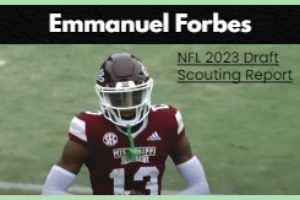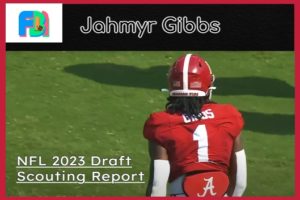Intro to The EDGE Position
Easily one of the most exciting and important positions in football is the EDGE position. Besides QB, no single player can impact the game more than a pass rusher. While it’s practically impossible to be a consistent shutdown corner, the best EDGEs can consistently dominate games. looking back at the drafts from this past decade, there have been 14 EDGEs taken in the top-five picks since 2013. Furthermore, the average cap allocation for EDGEs is 23.6 million which is by far the most on defense. That is a testimony to how valuable this position is viewed by the league. In this article, we discuss the importance of each trait/ skill related to EDGE and explain how to assess these traits through film and stats.
It is also important to understand what exactly an EDGE is compared to an outside linebacker (OLB) or defensive end (DE). Because a 4-3 DE and a 3-4 OLB play essentially the same position, but with minor differences, the term EDGE is used to encapsulate both into one position group. This change in terminology occurred in the mid-2000s and can still confuse some fans. The video game series Madden and the pro bowl in particular have made the mistake of not including the EDGE terminology on their rosters. Hopefully, in the future, this starts to change so it becomes widely understood.
By far the most common misconception about pass rushers is sack totals. Many casual fans have the impression that sacks are by far the most valuable stat to look at, but this is flat-out wrong. Pressure totals are a much more reliable stat to pay attention to. This is because sacks are often a result of partial luck. The only difference often between getting a sack and a QB hit more often than not is just the QB made a quick decision and didn’t allow time for a sack. More often than not when an EDGE gets pressure, they aren’t getting a fair shot at a sack. A lot of sacks will happen because of poor pocket sense or the pass rusher will go unblocked. In that case, it’s not any better than winning and forcing the QB to scramble. When looking at year-to-year stats, pressure totals turn out to be much more consistent while sack totals are racked up at a more inconsistent rate on a year-to-year basis. Ultimately pressure totals are just a stat and it’s always most revealing to watch the actual play, but this stat must be better understood.
Athleticism
Even though this isn’t the most important aspect of playing EDGE, it is best to first explain how athleticism impacts and crosses over to the rest of the traits before explaining them later. Similar to most positions, the physical tools of an EDGE are strongly connected to the upside of the various traits of the position. This article will break down how each physical trait crosses over to other traits.
Speed is crucial to have to be a consistently dominant player. Not only does it help significantly with stunts and free rush blitzes, but it allows the EDGE to close on the QB and get the sack more frequently. It is more than possible to win without great speed, but having it allows the EDGE to be used in more ways and gives them better chances of getting sacks. This also gives the EDGE rusher a chance to get pressure on designed QB rollouts. The most dominant EDGE rushers in the league all have high-end speed or at least to an extent. In the aspect of run defense, it allows them to track down the runner from behind and to have general range when in pursuit. Speed can be useful in many ways, and it’s a small detail that has an unexpected value. Besides 40 times, watching big run plays can sometimes give a good idea of true speed.
Acceleration or explosiveness goes hand in hand with the term get-off and is a crucial aspect of playing the position. Get-off will be further explained later on, but the difference between get-off and acceleration is this. Acceleration is someone’s raw burst in a standing position while get-off is the quickness of their first step in their particular stance and the consistency at which they time it correctly. Acceleration is a natural gift for the most part while get-off is learned more over time. Acceleration in the case of a D-lineman is graded based on how quickly they get to top speed after their first step. This trait is useful both in pass rush and run defense. The twitchier and more explosive the EDGE is, the harder it is to get your hands on them. In addition, it makes it more difficult to gain leverage against them. In run defense, it can make up for poor play recognition as they can cover more ground quicker. A good burst is also needed to blow up a run play in the backfield.
Agility is good to have as a pass rusher and in run defense. It will not necessarily hold powerful players back from becoming elite, but it adds an extra element to their game. As a pass rusher, it is needed to execute various pass rush moves which will be broken down in detail later. In run defense, lateral quickness is needed to both sidestep against blocks and to have better range in pursuit of the ball carrier.
Size And Strength
For multiple reasons, size and strength are other huge aspects of the EDGE position. While height and weight matter, what is truly important regarding size is arm-length. This is because certain pass rush moves are drastically limited with short arms. In addition, length greatly helps with shedding blocks and making tackles while giving d-lineman the needed leverage to use their power to shed blocks in run defense. The length of an EDGE is important when assessing the potential of traits like this. The raw power a player displays is also a huge difference-maker. This can be noticed when an EDGE isn’t in a good position to shed or pull off a power move but can win with raw strength instead of good technique. Strength also allows the player to make up ground while engaged with a blocker. It impacts the upside of certain pass-rush moves and block-shedding abilities as well. How exactly length and strength tie into pass rush moves will be detailed in the pass rush section.
Get-off
The combination of raw burst and get-off on the line of scrimmage is the single most important aspect of playing EDGE. There’s a reason the best EDGE rushers have insanely high split times and are constantly trying to time the snap. Because there is sometimes a big difference between acceleration and a player’s get-off, it is graded separately. A player might be able to accelerate very quickly running a 40-yard dash but then not be as quick on the line of scrimmage because a different technique is required. Both the technique and the consistency of a player’s get-off are what’s most important to pay attention to. This tweet below by Rob Guerrera reports Nick Bosa improved his 10-yard split time by over a twentieth of a second and this doesn’t account for the consistency he has in-game.
Not only does Nick Bosa have an incredible raw ability to accelerate, but he consistently has great timing and technique on the snap. This is why many EDGEs struggle early on and take time to become dominant in the pros. Brett Kollmann has a great Youtube video that breaks down in detail Bosa’s get-off, called ‘The Hidden Technique of Nick Bosa‘. Most EDGE defenders have an unnecessary hitch in their get-off or will have an extra step in their stance. The best EDGEs don’t do this.
Not only do the best EDGEs time the snap so well, but they are often particularly good at exploding out of their stance compared to how they accelerate. This is why it’s important to pay attention to broad jump numbers as it indicates how explosive they are out of a stance. Some players might be very quick, but lack this explosiveness which is another reason it’s graded separately. To get the full picture of an EDGE, you see how they fare in every single one of these categories.
Getting a great get-off allows the D-lineman to set up his pass-rush moves with better leverage and allows him to win with speed. Good pass-rush moves almost always start with a good get-off. To convert speed to power effectively, high-end get-off and explosiveness are needed. Furthermore, it can make a huge difference in run defense. It can generally compensate for poor athletism and give average players an extra edge.
Bend
A trait that is not often discussed in the media but carries great value in pass rushing is Bend. Bend is essentially the ability to turn and flip your hips, so your body is parallel with the QB as you beat the outside corner of the pocket. This is a skill that pretty much every elite EDGE rusher has. It allows the EDGE to pursue the QB after winning against the Tackle from the outside. In addition, bend is required to pull off an array of different pass rush moves. In some cases, the bend is needed to become square with the QB even on an inside-winning move. The key to having a good bend is staying low without losing momentum. To do this, it takes balance, agility, fluidity, and body flexibility. Von Miller in particular was famous for his bend as he almost always used it. Because bend is needed to win with pure speed and is required to pull off a handful of pass-rush moves, it is an important aspect to be aware of.
Power Moves
The power-rushing element of EDGE rushers has become more widely coveted and desired over recent years. This boils down to it being faster to reach the QB with power than it is with finesse. This is because finesse moves take a little extra time to set up while a power move doesn’t require the same lengthy process. A bull rush for example goes in a straight and narrow direction while a swipe move requires extra hand usage and for the pursuit to the QB to be taken out a wider angle. While finesse moves are generally won more often, QBs have gotten so good at quickly getting the ball out. Plus, QBs are more mobile than ever, giving pass rushers less time to hit home. This in turn makes the best power rushers more valuable. Here we explain how each pass-rush move works and the sub-traits involved with each one. Each one is broken down alone, but all these moves can be turned into counter and combo moves.
The bull rush can be one of the quickest and most effective ways to win a rep. Due to this, it’s one of the most commonly used moves, if not the most used, by powerful players. The most crucial aspect of winning with a bull rush is the ability to convert speed to power. This is because Tackles are always bigger and often stronger than the EDGE rusher, so the element of speed is needed to have that extra advantage. To win covert speed to power, the EDGE must have his upper and lower body in sync as he engages with proper timing. When executing a bull rush, length is also needed to keep distance from their body as they push with force and it allows them to extend further into the lineman. Having length also prevents the O-lineman from being able to reach his chest as the bull rush is executed. Some of the best current bull rushers are Rashan Gary, Nick Bosa, and Maxx Crosby. One thing all these guys have in common is that they’re dominant athletes. That’s what will translate to the best possible bull rush.
The long arm is similar to the bull rush but with a different variation. This move requires just your inside hand to be used while also requiring more bending. The key to this move is to sell speed, then transition to power. This move allows the EDGE to create good space between the Tackle. Pulling off this move takes good arm length and fluid hips to bend as the long arm is executed. In addition, it specifically requires strong shoulders. Khalil Mack is famous for this move as it was his go-to for most of his career. Mack had elite bend and strength, allowing him to pull it off easily. The arm-over move is very similar to the swim move and long arm move but requires more power than finesse. This move starts with a swat with the inside arm and then leads to the right arm crossing over to propel forward. It requires quick hips and good arm length to pull off.
The cross-chop is arguably the most difficult move to stop in football, but equally as hard to pull off. It involves a swat to the left hand, then the EDGE crosses sides and follows through with a chop across the body as they propel forward. The key to this move is to trap the O-lineman’s arm essentially. A variation of this would involve a euro step to start it off to catch the Tackle off guard. Using the variation has proven to be more effective, but also a more difficult task. This move takes high-level get-off, bend, and power to execute. It is a common move to try and pull off, but very few can do it consistently. IDL Aaron Donald has made his own version of this move with an extra hop added to it. The article ‘Under the Microscope: The Cross-Chop Technique‘ by Brandon Thorn has a great analysis of this pass rush move. This tweet below has a video that greatly demonstrates the move.
The rip move is another very common and effective pass-rush move. It starts with establishing contact by grabbing the inside hand of the Tackle with the EDGE’s inside hand, then the EDGE rips the Tackle’s shoulder down as he propels forward. This move requires the EDGE to have a low center of gravity and takes great lower and upper body strength. It is no easy feat to pull this off, but when done properly it throws off the balance of a Tackle who even has good technique. This can be used in counters and combined into moves such as the dip and rip or the swipe and rip. The most common rip move is a simple club rip which starts with a club to the hands of the Tackle.
Speed And Finesse Moves
Speed and Finesse moves used to be the go-to pass rush option for most of the league’s best EDGEs. However, as the NFL has adapted, these pass-rush moves haven’t been the best way to attack the QB. These pass-rush moves are still exceptionally impactful when executed properly and are necessary for a handful of situations. Even if power rush moves are generally better, there will be times when finesse moves will be the better option. There are still a ton of great speed/finesse rushers in the league, but it’s just the very best all lean more toward power.
The most generic pass-rush move of them all is the classic ‘speed rush’. This is a move that is one with pure speed and bend essentially. This move can be very effective if the EDGE’s athletic traits are sufficient. Because the Tackle can’t get too much depth as he’d give up his inside shoulder, the EDGE has the advantage of being able to attack the outside with good leverage. The best pure-speed rushers will also have a threat of power in their game which keeps Tackles guessing which move will be used.
The swim move is one of the most popular pass rush moves and is also one of the most difficult to pull off cleanly. It requires length and great finesse from the pass rusher. It starts with a slight stutter or a swat to the hands. Then the EDGE needs to reach the outside shoulder of the Tackle and ‘swim’ past them. A swim move should generally be used on shorter offensive linemen. This is because it’s hard to reach the outside shoulder of the lineman if they’re tall. It’s a very effective move when used properly and is the go-to move for some of the best EDGE rushers ever to do it. Some of the best swim moves have come from players like J.J. Watt and Calais Campbell.
The swipe move, while nothing crazy is an easy, yet effective move to pull off. It’s simply a stutter step or some sort of fake that leads to the EDGE using their hands to fight off contact as they bend the corner. The key to this move is not to allow the Tackle to reach the chest of the EDGE. When done correctly, it is a great way to avoid the anchor of the Tackle. It takes high-level agility and hand quickness to pull this one off. This move can also be combined into a swipe-rip move, making it much more difficult to stop. EDGE Chase Young is excellent at pulling this particular move off. He does it by setting up the swipe move, to then simply finish off the Tackle by executing an extra rip move.
A spin move is one of the most basic but effective pass-rush moves. It seems very simple, but it takes quickness, finesse, and even some power to execute properly. To pull off a good spin, the EDGE must sell a speed rush or bull rush then pivot and execute the spin with proper timing. The EDGE can also attempt to sell a rip move to then set up an inside spin. There are different variations of how to pull this off, and some do certain variations better than others. Depending on how many other pass rush moves can be executed, the easier this is to set up.
Run Defense/ Tackling And Coverage
The trait block shedding is the most important run defense trait for all D-linemen. That’s because most run plays involve head-to-head contact which requires strength and the ability to shed blocks to impact the play. To shed a block, the EDGE needs to square up with the blocker and engage with strong hands, and have good placement. He then would have to extend his arms and sidestep as he disengaged with the blocker. Because good hand placement is required, it can take time for some D-lineman to reach their potential in this regard. Players with longer arms with more powerful hands have an advantage in shedding blocks. This is why the best run-defending EDGEs are all long and very powerful.
Tackling and block shedding often correlate because both require length and a degree of discipline and technique. Tackling won’t make or break the overall grade of an EDGE, but it’s easy to pay attention to and still brings value. Stats such as missed tackle rates are a great stat to look at in this regard. In terms of film, pay attention to the type of players they can take down and whether they can get strip sacks. The best tacklers are disciplined and can make splash plays by forcing fumbles.
Run instincts or play recognition is one of the most important traits in run defense for EDGEs. Whether or not a player is physically capable of making a run-stop, they must be prepared and be able to recognize what the play is. Play action is more used than ever, and misdirection is often used to fake out the defense. The best run defenders can diagnose a play as a run and be aware of who has the ball. The quickness of how they react is key to pay attention to as it makes a big difference. Being able to recognize a screen pass can be huge, and most defenders won’t do this.
Run pursuit is another big aspect to run defense, specifically for players like EDGE. When setting the edge on a run play, it’s crucial not to over pursue or give up too much outside space. In addition, the difference between the efforts of some players can be immense. That’s why effort severely affects the grade of the pursuit trait using our scale. Some players do not take run defense too seriously and in turn, don’t show off great pursuit to the ball carrier.
The impact of coverage for EDGE players is small but still needs to be noted. Not every EDGE needs to be good in coverage, but it is an added bonus when they are good. The task in coverage for an EDGE is typically rather simple. It usually involves running shallow hook zones or running man-to-man with a back or blocking TE. They’ll be at a severe disadvantage if they’re tasked with anything harder. It is important to pay attention to their specific task in coverage to determine if it’s a fair ask.
Conclusion
Another misconception about D-lineman in general is that low snap counts on early downs are a bad sign. More often than not, this is just because pass rush snaps are so important and it can be better to preserve stamina on less meaningful reps. Sometimes a player is just flat-out bad in run defense and is subbed out in those situations for a reason. That’s why it’s important to watch the film as mentioned in ‘The Proper Way to Analytically View Football.’ By watching the film, you get a picture of how well they play in run defense which gives an explanation for the number of snaps in run defense.
One last topic to go over is the aspect of football IQ. The best EDGE rushers always have a plan to attack the opposing O-lineman. In addition, they know how to counter and use situational awareness to figure out the best plan of attack. Depending on certain circumstances or trends in a game, a given pass rush move might be a better option than another. One nuance to the EDGE position is figuring out if an O-lineman is tipping run or pass. Some of the best and most experienced EDGEs will always catch on to this, though this is hard for the viewer to notice. The football IQ trait won’t make or break a player, but it’s an extra layer to the position that’s worth being analyzed.
As you can tell, there is a ton of information to be learned about EDGE, and similar to the QB Positional Analysis, this topic could be made into a book. Everything there is to know about EDGE for the casual football fan is here. If interested in learning even more about pass rush moves, read ‘The Art of the Pass Rush: Part 1‘ by Nick Falato, for an even more detailed breakdown. If you’d like to understand how each trait is weighted in the grading process, take the time to look at the formula tab of FBI’s 2023 Draft Sheet. Coming soon will be an EDGE rankings article that will go deep into the very best EDGEs. If you have any thoughts or feedback, leave it on Twitter @FBIntellect.







Recent Comments